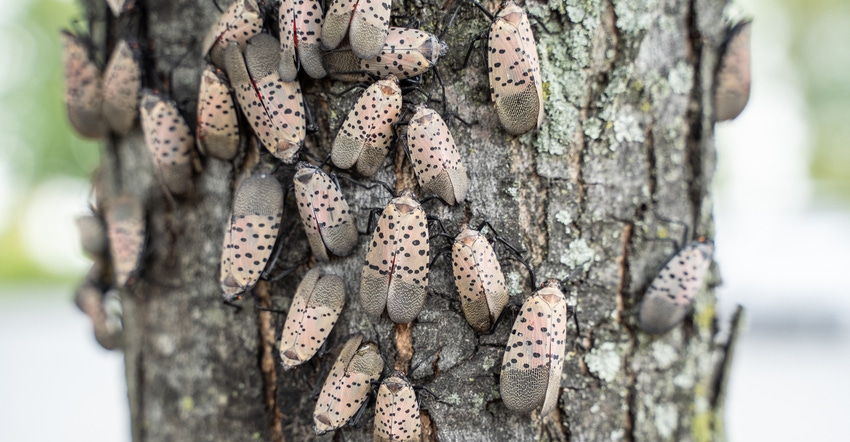January 28, 2020

If not contained, the spotted lanternfly could potentially cost Pennsylvania’s economy at least $324 million a year and cause the loss of about 2,800 jobs, according to a study carried by economists at Penn State’s College of Agricultural Sciences.
Under a worst-case scenario — in which damage reaches the maximum projected by crop-production and forestry experts — these losses could increase to $554 million a year and almost 5,000 jobs.
The report, the first to estimate the potential financial ramifications of the spotted lanternfly, places current economic damage from spotted lanternfly at $50.1 million a year and a loss of 484 jobs in the southeastern part of the state.
“Even if the worst-case scenario doesn’t come to pass, the spotted lanternfly already has inflicted millions of dollars in damage to our state’s agriculture and forestry industries,” says Jayson Harper, professor of agricultural economics and director of Penn State’s Fruit Research and Extension Center.
“Our findings demonstrate that the vigorous response by the Pennsylvania Department of Agriculture, U.S. Department of Agriculture, Penn State and industry stakeholders to limit the spread of spotted lanternfly is clearly warranted; our economy depends on it.”
Native to Asia, the spotted lanternfly first was discovered in Berks County, Pa., in 2014. It has spread to Bucks, Carbon, Chester, Dauphin, Delaware, Lancaster, Lebanon, Lehigh, Monroe, Montgomery, Northampton, Philadelphia and Schuylkill counties, all of which are under a state-imposed quarantine.
Data shows impacts
The study was conducted by Harper; Timothy Kelsey, professor of agricultural economics and co-director of the Center for Economic and Community Development at Penn State; Lynn Kime, senior Extension associate in agricultural economics; and William Stone, an undergraduate student majoring in community, environment and development.
They used data from government reports, crop-production experts, industry surveys, and interviews with stakeholders, Penn State researchers and Extension educators to come to their conclusions.
The team evaluated direct impacts, defined as the value of lost crops and revenue to farmers and forest landowners; indirect impacts, such as decreased purchase of goods and services from businesses that support those growers; and induced impacts, which focuses on reduced household spending due to lost work hours and household income.
Their predications are modeled on three scenarios: if spotted lanternfly is contained to the current 14-county quarantine zone; if it spreads to neighboring counties; and if it reaches all 67 counties in the state.
They used an economic-assessment software program called IMPLAN.
In the quarantine zone, damage currently is estimated to be $50.1 million per year with a loss of 484 jobs. If the worst-case scenario occurs, these losses could increase to $92.8 million a year with a loss of 927 jobs.
If the insect spreads into adjacent counties, expected losses would increase to $89.2 million per year with a loss of 843 jobs. If the worst-case scenario occurred, these losses would increase to $168.8 million a year with a loss of 1,665 jobs.
If it spreads throughout Pennsylvania, the expected losses would amount to $324.9 million a year with a loss of 2,810 jobs, or $554 million a year and the loss of 4,987 jobs under the very worse-case scenario.
The estimated annual direct economic impact of spotted lanternfly damage on agriculture thus far is $13.1 million in the quarantine zone, $7.7 million in the adjacent counties and $42.6 million statewide.
Agriculture hard hit
Agricultural sectors taking the brunt of those losses include nursery operators — to the tune of $8 million in the quarantine zone and $22.9 million statewide — fruit growers, especially grape growers, and Christmas tree growers.
If the worst-case scenario occurs, the annual agricultural losses would be an estimated $29.6 million in the quarantine zone, $20.4 million in the adjacent counties and $99.1 million statewide.
Costly to forestry
To calculate the direct effects on the state’s forest products industry, the researchers used data from the USDA’s Forest Inventory and Analysis database, quarterly price data from the Pennsylvania Timber Market Report, and a survey of forest-products experts.
The annual impact of spotted lanternfly feeding on forest trees is estimated to be $16.7 million in the quarantine zone, $15.6 million in adjacent counties and $152.6 million statewide.
While researchers are working to understand the direct long- and short-term effects spotted lanternfly has on its various host plants, the pest’s feeding can cause considerable economic damage to forests over time, especially to soft maple, various oak species and black walnut.
If the worst-case scenario occurs, the economic effects on forestry could be $25.8 million in the quarantine zone, $25.2 million in adjacent counties and $236.3 million statewide.
The study also looked at the cost to implement best management practices, including employee education, pest monitoring and inspection, phytosanitation, and removal of Ailanthus altissima, commonly called tree of heaven, a preferred host of the pest. The team came up with estimates ranging from $27.9 million in the quarantine zone to $219.6 million statewide, depending on the industry sector and geographic location.
The study was funded by the Center for Rural Pennsylvania, a legislative agency of the Pennsylvania General Assembly. The full report can be found on the center’s website.
Source: Penn State Extension, which is solely responsible for the information provided and is wholly owned by the source. Informa Business Media and all its subsidiaries are not responsible for any of the content contained in this information asset.
You May Also Like




